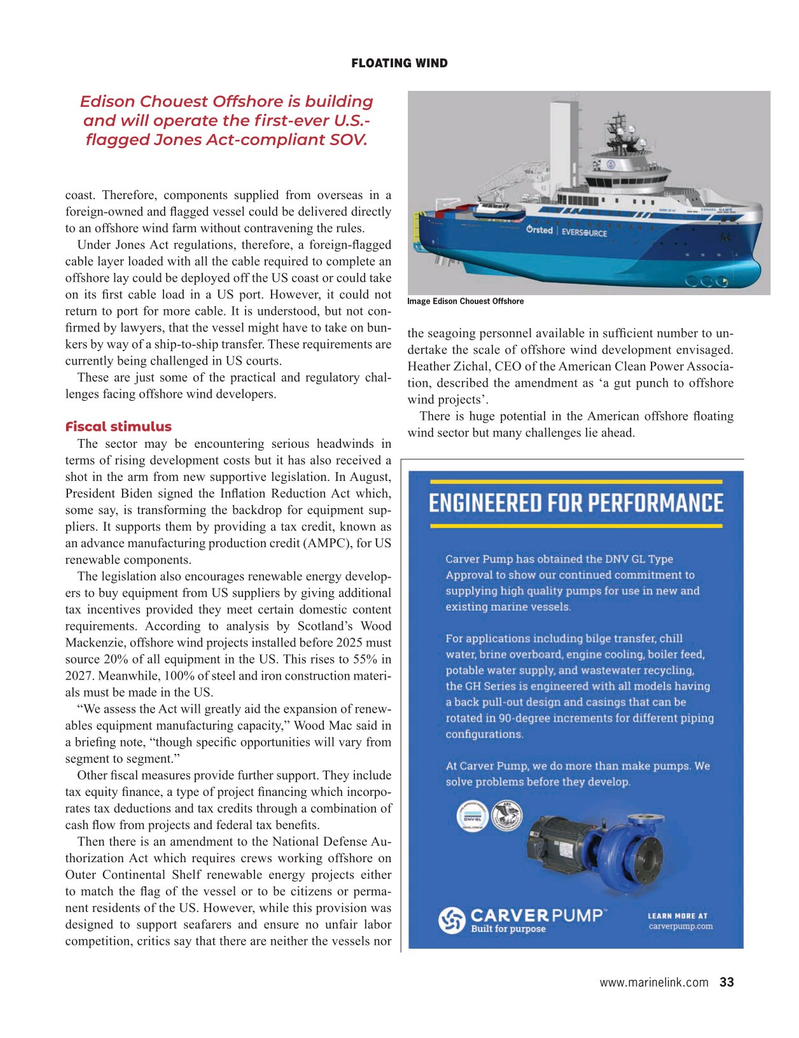
Page 33: of Maritime Reporter Magazine (February 2023)
Government Shipbuilding
Read this page in Pdf, Flash or Html5 edition of February 2023 Maritime Reporter Magazine
FLOATING WIND
Edison Chouest Offshore is building and will operate the ? rst-ever U.S.- ? agged Jones Act-compliant SOV.
coast. Therefore, components supplied from overseas in a foreign-owned and ? agged vessel could be delivered directly to an offshore wind farm without contravening the rules.
Under Jones Act regulations, therefore, a foreign-? agged cable layer loaded with all the cable required to complete an offshore lay could be deployed off the US coast or could take on its ? rst cable load in a US port. However, it could not
Image Edison Chouest Offshore return to port for more cable. It is understood, but not con- ? rmed by lawyers, that the vessel might have to take on bun- the seagoing personnel available in suf? cient number to un- kers by way of a ship-to-ship transfer. These requirements are dertake the scale of offshore wind development envisaged. currently being challenged in US courts.
Heather Zichal, CEO of the American Clean Power Associa-
These are just some of the practical and regulatory chal- tion, described the amendment as ‘a gut punch to offshore lenges facing offshore wind developers. wind projects’.
There is huge potential in the American offshore ? oating
Fiscal stimulus wind sector but many challenges lie ahead.
The sector may be encountering serious headwinds in terms of rising development costs but it has also received a shot in the arm from new supportive legislation. In August,
President Biden signed the In? ation Reduction Act which, some say, is transforming the backdrop for equipment sup- pliers. It supports them by providing a tax credit, known as an advance manufacturing production credit (AMPC), for US renewable components.
The legislation also encourages renewable energy develop- ers to buy equipment from US suppliers by giving additional tax incentives provided they meet certain domestic content requirements. According to analysis by Scotland’s Wood
Mackenzie, offshore wind projects installed before 2025 must source 20% of all equipment in the US. This rises to 55% in 2027. Meanwhile, 100% of steel and iron construction materi- als must be made in the US. “We assess the Act will greatly aid the expansion of renew- ables equipment manufacturing capacity,” Wood Mac said in a brie? ng note, “though speci? c opportunities will vary from segment to segment.”
Other ? scal measures provide further support. They include tax equity ? nance, a type of project ? nancing which incorpo- rates tax deductions and tax credits through a combination of cash ? ow from projects and federal tax bene? ts.
Then there is an amendment to the National Defense Au- thorization Act which requires crews working offshore on
Outer Continental Shelf renewable energy projects either to match the ? ag of the vessel or to be citizens or perma- nent residents of the US. However, while this provision was designed to support seafarers and ensure no unfair labor competition, critics say that there are neither the vessels nor www.marinelink.com 33
MR #2 (18-33).indd 33 2/3/2023 10:11:49 AM

 32
32

 34
34
